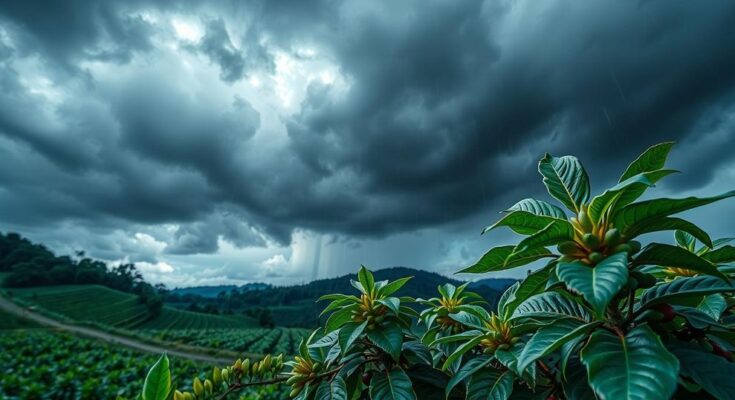May arabica coffee prices have fallen to a 1-1/2 week low due to forecasts of widespread rains in Brazil, easing dryness concerns. Increased ICE coffee inventories and predictions of a larger global surplus also contributed to declining prices. Meanwhile, ongoing supply challenges in Brazil and Vietnam’s reduced production add complexity to the market dynamics.
The coffee market is currently experiencing downward pressure, with May arabica coffee prices dropping by 0.23% to a 1-1/2 week low. This decline is attributed to favorable weather forecasts from Somar Meteorologia, predicting widespread rains in Minas Gerais, Brazil’s primary arabica-producing region, which alleviates previous drought concerns. Simultaneously, ICE coffee inventories have increased, exacerbating these price declines.
On Tuesday, arabica coffee inventories on ICE reached a one-week high of 803,032 bags, while robusta inventories also rose to a one-month high of 4,356 lots. A report from Marex Solutions further dampened market sentiment by predicting a significant coffee surplus in the 2025/26 season, widening to 1.2 million bags from a previous surplus of only 200,000 bags.
Contributing to the bearish outlook, Vietnam’s General Statistics Office reported a 6.6% year-on-year increase in coffee exports, further undermining robusta coffee prices. Despite the bearish sentiment, there is a supportive factor for coffee prices due to below-normal rainfall affecting Brazil’s arabica crop. Recent data indicated rainfall in Minas Gerais was recorded at only 1.1 mm recently, or 2% of the historical average.
Concerns regarding supply have remained prevalent, as Cecafe reported a 1.6% year-on-year decline in Brazil’s green coffee exports, totaling 3.98 million bags in January. Additionally, Brazil’s government crop forecasting agency Conab has reduced its coffee crop estimates for both the 2024 and 2025 seasons, indicating a continuing trend of lower production.
The ongoing drought caused by El Nino has been detrimental, with Brazil experiencing its driest conditions since 1981. This weather phenomenon has caused significant damage to coffee plants during critical growth periods. Colombia, another leading producer, is also facing challenges in recovering from the recent drought.
Robusta coffee prices are seeing some support due to reduced production capacity in Vietnam, where output may decline by 20% in the upcoming crop year. Projections indicate a slight drop in Vietnam’s coffee production for the 2024/25 marketing year, alongside a report indicating a sharp decrease in coffee exports.
There are mixed signals regarding global coffee exports, with Conab reporting a record increase in Brazilian coffee exports, while the International Coffee Organization noted a decrease in global export volumes. The USDA’s biannual report predicts an increase in world coffee production overall but suggests challenges specific to Brazil and potential declines in inventories.
Finally, Volcafe revised its Brazilian arabica coffee production forecast downward for the 2025/26 marketing year, reflecting significant drought conditions. This adjustment suggests a broader trend of deficits that may impact coffee prices moving forward.
In summary, the outlook for the coffee market remains complicated, with various factors contributing to price declines. Forthcoming rains in major producing regions alleviate some drought concerns, while increasing inventories and projected price surpluses indicate a bearish trend. Additionally, supply chain issues and weather-related challenges continue to shape the market dynamics, leading to mixed forecasts for global coffee production and prices in the upcoming seasons.
Original Source: www.tradingview.com




